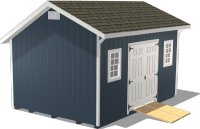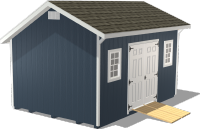Exploring Budget Considerations Across Various Greenhouse Sizes
by Dakota Storage Buildings, on September 10, 2024

When it comes to purchasing a greenhouse, there’s more to consider than just the initial greenhouse cost. Evaluating all financial aspects is essential for ensuring long-term success and sustainability. From installation and energy systems to ongoing maintenance and regulatory requirements, understanding the full scope of expenses helps you make an informed decision. This approach ensures that your greenhouse aligns with your budget and gardening goals, leading to a thriving and efficient growing environment.
Balancing Greenhouse Sizes, Designs, and Materials for Your Greenhouse
When selecting a greenhouse, several factors must be considered, such as greenhouse size, design, and purpose. The intended use of the greenhouse — whether for hobby gardening, commercial production, or educational purposes — will significantly influence your choice. For instance, a small greenhouse might prioritize aesthetics and ease of use, while a commercial greenhouse needs to maximize space and efficiency.

Size: The size of a greenhouse is one of the first decisions you will need to make. A large greenhouse provides more space for plants and equipment but will also have higher initial and ongoing greenhouse costs. Smaller greenhouses are more affordable and easier to manage but may limit the scope of your gardening projects.
Design: The design of the greenhouse should complement its intended use. Traditional designs provide a classic look and can be integrated into the existing landscape of a home garden. More modern designs, like dome or gothic arch greenhouses, can offer superior structural integrity and efficiency, especially for larger operations.
Different materials offer various benefits and drawbacks. By evaluating the long-term benefits and potential drawbacks of each option, you can ensure that your greenhouse investment is sound and aligned with your goals.
Polycarbonate: Durable and offers good insulation but can be more expensive than plastic. Polycarbonate panels are lightweight, shatter-resistant, and provide excellent thermal insulation, making them suitable for year-round use. Polycarbonate greenhouses can vary significantly based on the greenhouse size, ranging from a few hundred dollars for mini greenhouses to several thousand for larger commercial setups.
Glass: Provides excellent light transmission and aesthetic appeal but is fragile and costly. Glass greenhouses offer a classic look and superior clarity but require sturdy frames and are easy to break. Small greenhouses might start at around $1,000, while larger, more durable models can reach upwards of $15,000.
Plastic: Cost-effective and easy to install but less durable and harder to insulate. Plastic covers are lightweight and flexible but may need frequent replacements due to wear and tear. These are the most affordable options, with prices starting as low as $200 for small greenhouses and increasing with size and durability.
Key Factors in Greenhouse Foundation and Installation
A proper foundation is essential for the stability of your greenhouse. It supports the entire structure, ensuring it remains level and secure, which is crucial for preventing damage from environmental factors like wind and shifting soil. A strong foundation also helps maintain the integrity of the greenhouse's frame, reducing the risk of structural failures and prolonging the lifespan of the greenhouse. Proper drainage is another critical aspect of a good foundation, as it prevents water accumulation that can lead to rot, mold, and other issues.
.jpg?width=900&height=450&name=Blog_Greenhouse%20Foundation_900x450%20(2).jpg)
Common Foundation Types
Concrete: Highly durable but more expensive. Concrete foundations provide a solid, permanent base that can withstand heavy loads and resist shifting, making them ideal for any greenhouse. According to Home Guide, it costs between $6 and $12 per square foot on average to lay a concrete foundation.
Timber: Less costly and easier to install but may require more maintenance. Timber foundations are suitable for smaller greenhouses and offer flexibility in design but may be susceptible to rot and pests if not properly treated. Timber foundation costs can vary from $100 to $500 or more based on greenhouse sizes and the cost of materials.
Deciding between a professional installation, which offers reliability but at a higher cost, and a DIY installation, which can save money but requires more effort and expertise, is an important consideration. Professional installation ensures that the foundation is laid correctly and meets all necessary standards, providing peace of mind and potentially saving money on future repairs. Be sure to obtain detailed quotes and compare service providers to understand how much this would cost. DIY installation can save on labor expenses and allow for customization but requires construction knowledge, proper tools, and significant effort. Without the right knowledge, you may risk potential errors that could affect the greenhouse's stability and longevity.
Energy-Efficient Heating and Cooling Systems
Heating and cooling systems are vital to maintain optimal growing conditions in a greenhouse. These systems ensure that plants thrive by providing the ideal temperature, regardless of external weather conditions. Proper heating and cooling systems help prevent extreme temperature fluctuations that can stress plants, leading to poor growth and reduced yields. These systems help create a consistent environment that supports year-round gardening and can extend the growing season.
Heating
- Electric heaters are easy to install and control but can be costly to operate.
- Gas heaters provide consistent heat and are more cost-effective for large greenhouses.
- Solar heaters are environmentally friendly but require significant upfront investment.
Cooling
Proper ventilation is crucial. Look into energy-efficient solutions like automatic vent openers or adding shade cloths. Ventilation systems, such as exhaust fans and louvers, help regulate temperature and humidity levels, preventing overheating and promoting healthy plant growth.
2 Budget-Friendly Heating and Cooling Tips
Investing in energy-efficient systems can reduce long-term operational costs. Here are two tips to help you save money on heating and cooling:
- Utilize thermal curtains or bubble insulation to retain heat during colder months and reduce heating expenses. This can save 10-20% on heating costs, depending on the size and type of insulation used.
- Consider integrating smart technology to monitor and control climate conditions remotely, optimizing energy use. Smart systems can lead to savings of up to 8% on energy bills.
Implementing Efficient Irrigation in Your Greenhouse
A reliable irrigation system is crucial for plant health as it ensures that plants receive the right amount of water at the right times. Proper irrigation helps maintain consistent soil moisture levels, which is vital for plant growth and development. Without an effective irrigation system, plants can suffer from either water stress due to under-watering or root rot and other issues caused by over-watering. Consistent watering schedules provided by reliable irrigation systems also help to establish strong root systems, leading to healthier and more resilient plants.

Drip Irrigation: Efficient and conserves water but can be costly to install. Drip systems deliver water directly to the plant roots, minimizing evaporation and runoff, making them ideal for water conservation. Costs can range from $100 for a small greenhouse to $1,000 or more for larger greenhouses.
Misting Systems: Ideal for maintaining humidity but may require frequent maintenance. Misting systems create a fine mist that cools the air and increases humidity, which is beneficial for tropical plants and seedlings. Initial costs for misting systems can range from $50 to $500.
Automated Systems: Convenient but potentially expensive. Automated systems use timers and sensors to regulate watering schedules, ensuring consistent moisture levels and reducing labor costs. These systems can cost between $200 and $2,000 depending on complexity and greenhouse sizes.
Consider initial setup costs and maintenance needs, and implement water conservation strategies to reduce greenhouse costs. Rainwater harvesting systems can supplement irrigation needs and lower water bills, while soil moisture sensors can optimize watering schedules based on real-time data.
Ensure Adequate Light for Year-Round Plant Growth
Supplemental lighting is necessary in regions with limited sunlight to ensure plants receive adequate light for photosynthesis and growth. Natural sunlight can vary greatly depending on the season, weather conditions, and geographical location. Without adequate light, plants can become leggy, weak, and less productive, ultimately affecting their overall health and yield.
LED: Energy-efficient and long-lasting but with higher upfront costs. LED lights provide full-spectrum light, promoting healthy plant growth and reducing energy consumption.
Fluorescent: Lower initial cost but less efficient. Fluorescent lights are suitable for seedlings and low-light plants but may require frequent bulb replacements.
Calculate both the upfront costs and long-term energy usage to determine the most cost-effective solution. One way to optimize lighting efficiency, and potentially reduce electrical costs, is by using timers and reflectors to direct light where it is needed most. Consider the photoperiod requirements of your plants and adjust lighting schedules accordingly to promote optimal growth and yield.
Maintenance Strategies for a Healthy Greenhouse
Regular maintenance is essential for greenhouse longevity and optimal functionality. Without consistent upkeep, small issues can quickly escalate into major problems, leading to costly repairs and reduced productivity. Proper maintenance ensures that all systems are operating efficiently, providing a stable and healthy environment for your plants.

Cleaning: Regular cleaning prevents disease and pest buildup. Clean glazing materials, gutters, and vents to ensure maximum light transmission and proper airflow. Cleaning greenhouse costs can be minimal for DIY efforts, but professional services might charge a few hundred dollars, depending on the size of a greenhouse.
Pest Control: This is essential for plant health. Implement integrated pest management (IPM) strategies, including biological controls and organic pesticides, to minimize pest infestations. Pest control costs can vary widely, from $50 for DIY solutions to several hundred dollars annually for professional services.
Component Replacement: Replacing these items keeps systems functioning efficiently. Regularly inspect and replace worn or damaged components, such as seals, hoses, and fittings, to prevent system failures.
Estimate recurring maintenance costs and implement strategies to prevent costly repairs, like regular inspections and proactive replacements. Create a maintenance schedule and keep detailed records of all maintenance activities to track expenses and identify potential issues early. When equipment and the structure itself are properly maintained, it extends the life of your greenhouse and enhances its performance, ensuring a stable and productive growing environment. Additionally, staying ahead of maintenance needs can prevent small issues from escalating into major, costly problems, saving both time and money in the long run.
Managing Greenhouse Operational Costs
Operational expenses are a significant part of maintaining a greenhouse. Effectively budgeting for these ongoing expenses is crucial to ensure your greenhouse remains functional and efficient without compromising on quality. By regularly reviewing and adjusting your budget, you can account for fluctuations in operational costs and identify opportunities for savings.
Electricity: Monitor usage and invest in energy-efficient systems. Utilize renewable energy sources, such as solar panels, to offset electricity costs and reduce your carbon footprint.
Water: Use efficient irrigation methods and rainwater harvesting. Implement water-saving technologies, such as low-flow emitters and automated shutoff valves, to minimize waste.
Labor: Consider automation to reduce labor needs. Invest in labor-saving devices, such as automated vent openers and conveyor systems, to streamline operations and lower labor costs.
Budgeting for ongoing expenses helps maintain a functional greenhouse without compromising quality. Regularly review and adjust your budget to account for changes in operational costs and identify opportunities for savings.
Protect Your Greenhouse With Insurance and Permits
Insuring your greenhouse protects your investment and ensures that you are covered in the event of unforeseen circumstances. Adequate insurance coverage and adherence to local regulations are essential steps in safeguarding your greenhouse and its contents. Understanding the types of insurance available and the regulatory requirements can help you make informed decisions and avoid potential legal issues.

Structure Insurance: Covers damage to the greenhouse itself. This includes protection against natural disasters, vandalism, and accidental damage. For example, if a severe storm damages the greenhouse, structure insurance can cover the repair costs, ensuring that your operations are not disrupted for long.
Content Insurance: Protects plants and equipment. Ensure your policy covers high-value items, such as specialized tools and expensive plant varieties. Content insurance can be crucial if you grow rare or high-value plants, as it protects your investment in case of theft, vandalism, or environmental damage.
Check local regulations for necessary permits and budget for these fees to ensure compliance. Research zoning laws, building codes, and environmental regulations that may impact your greenhouse project. Obtaining the required permits and adhering to local regulations helps avoid fines and legal issues. By investing in the right insurance coverage and understanding local regulatory requirements, you can protect your greenhouse from potential risks and ensure smooth operations.
Tailoring Your Greenhouse to Fit Your Budget and Needs
Understanding the comprehensive cost considerations when purchasing a greenhouse is essential for making an informed decision. By adopting a thorough planning and budgeting approach, you can ensure the long-term success and sustainability of your greenhouse project. Explore our pre-built greenhouses or design your own with our 3D Configurator to find the perfect fit for your needs and budget. This tool allows you to customize every aspect of your greenhouse, from size and materials to roofline and features, ensuring you create a space that meets your gardening goals and financial constraints.

























